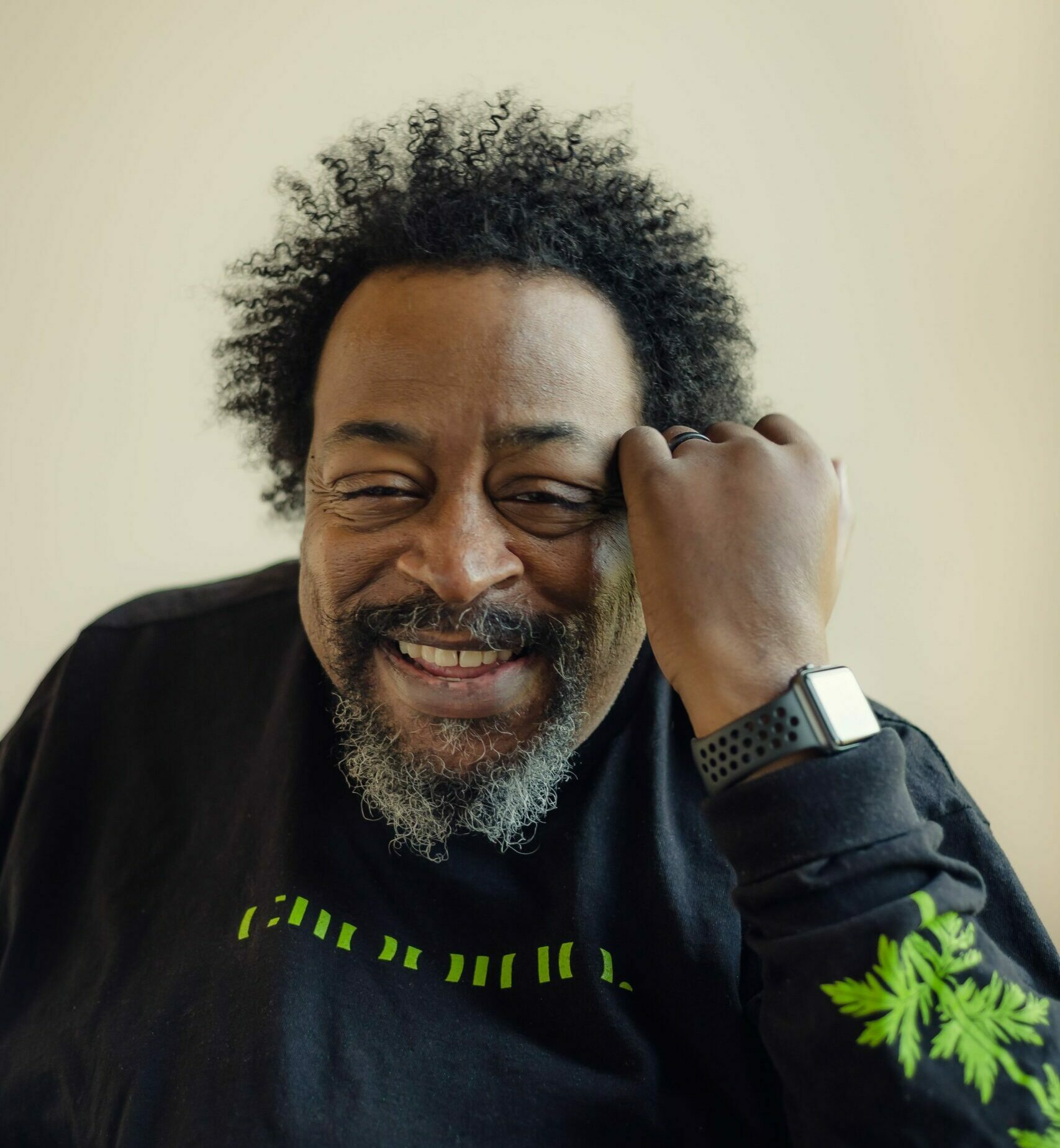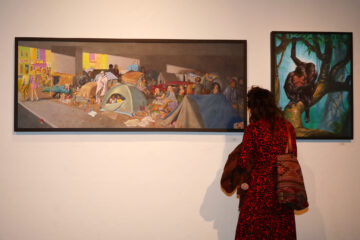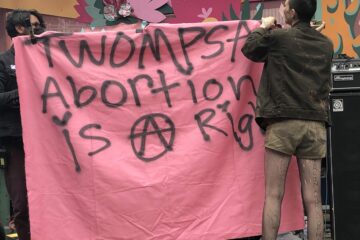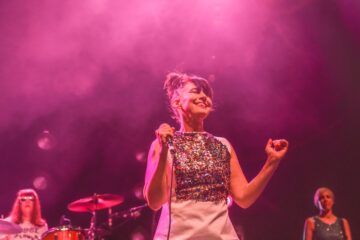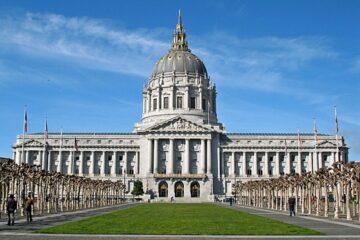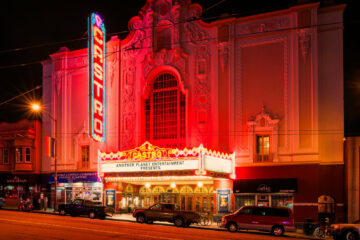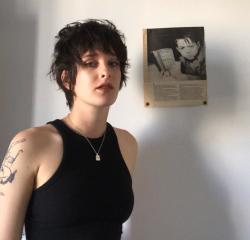Dax Pierson’s Latest Album, “Nerve Bumps,” is a Testament to His Resilience
“No artist is pleased … There is only a queer divine dissatisfaction, a blessed unrest that keeps us marching and makes us more alive than the others.”
― Martha Graham
“I’m a music producer because I’m such a music fan,” says Oakland-based musician Dax Pierson. “Since I like a lot of genres of music, it’s only natural for me to incorporate all of these things from different parts of my timeline…It’s what’s created me.”
As co-founder of Subtle and 13 & God, a touring member of Themselves, an associate of the Anticon Collective, and a former buyer for Amoeba Music, Pierson certainly has a substantial timeline to draw from.
One episode in particular, however, proved significantly life-altering.
In 2005, while on tour with Subtle, Pierson was irreversibly injured when the band’s tour van struck a patch of ice and flipped over. Pierson’s seatbelt malfunctioned, leaving him paralyzed from his torso to his feet.
A grueling decade in recovery came and went as Pierson adapted to his altered reality. However, abandoning his passion for music was not an option. Armed with an iPad and a digital audio workstation called Ableton Live, Pierson learned how to circumvent his physical restrictions.
In 2019, Pierson released “Live in Oakland” with Ratskin Records, his first musical release since the accident. Side A is a 2015 recording of Pierson’s debut performance at the DIY venue Life Changing Ministries, while Side B is a 2018 recording of his performance at the Pro Arts Gallery for the Stasis experimental arts festival.
Pierson describes his latest release, “Nerve Bumps (A Queer Divine Satisfaction),” as “a lot more meticulous, a lot more composed.” Tracks like “Catch” and “Keflex” bounce and writhe with the hypnotic precision of Kraftwerk. Meanwhile, “Adhesion” leads with the gripping, atmospheric weight of Angelo Badalamenti, before spinning gloriously into sonic oblivion.
Pierson notes that he doesn’t lead with concept, yet many “Nerve Bumps” tracks are imbued with poignant meaning. “For 2_24” commemorates the date of Subtle’s tour van accident, while “For the Angels” honors those that were lost in the 2016 Ghost Ship warehouse fire.
Following the release of “Nerve Bumps,” I spoke to Pierson about harnessing the “queer, divine dissatisfaction” attributed to being an artist, and the album that followed.
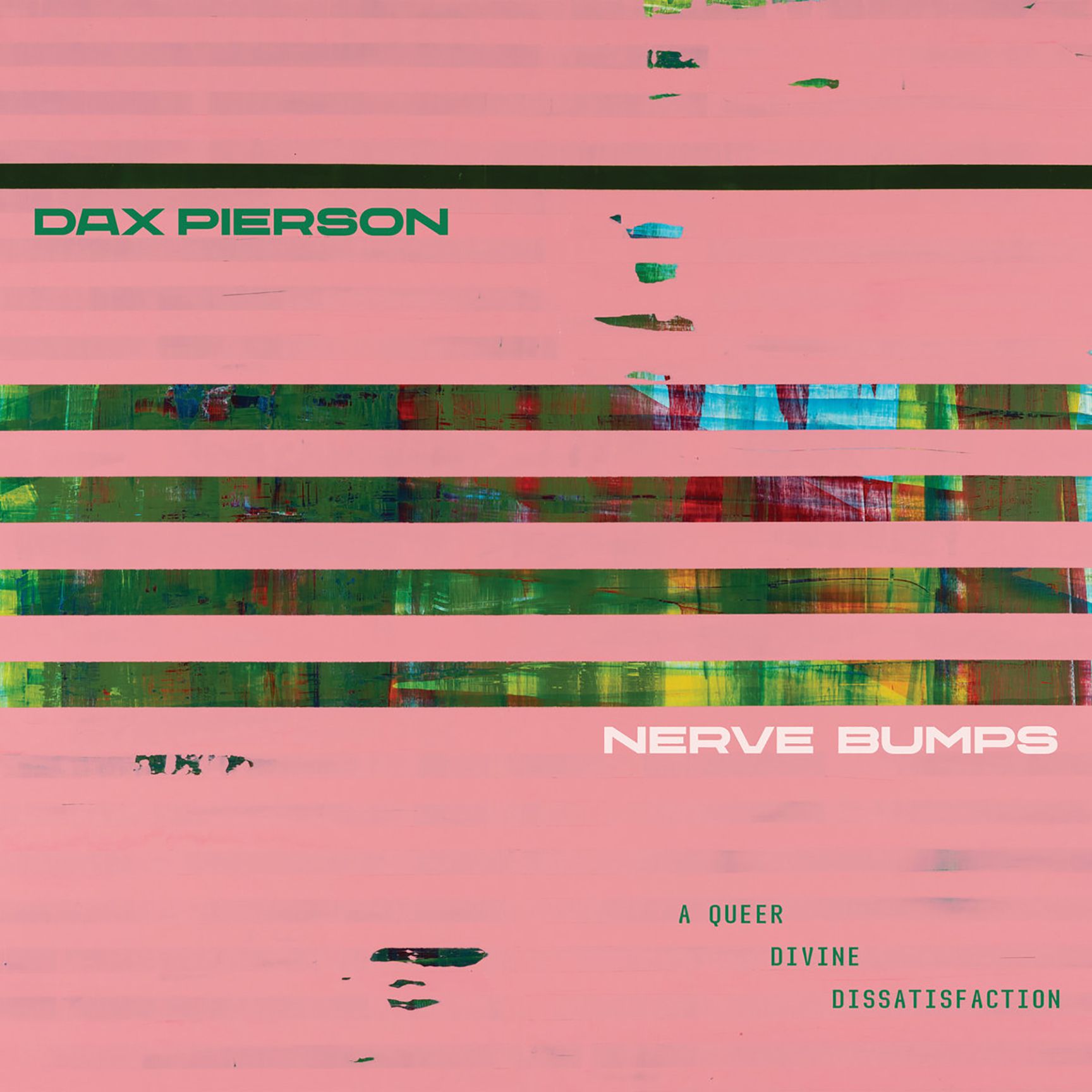
The cover for Dax Pierson’s 2021 release “Nerve Bumps (A Queer Divine Dissatisfaction)” (Photo courtesy Ratskin Records)
Much has been made of “A Queer Divine Dissatisfaction,” but what of “Nerve Bumps”? What does that title mean to you?
Well, it came simply as mispeaking of getting goosebumps. One day I was having a muscle spasm, which is pretty common for people with my disability, and for some reason I called it “nerve bumps.” It was just as simple as that. I was like, “Wow, that sounds like a good working title for an album.” So it’s been in the back of my mind as an album title, way before I started working on this album. I bounced it off of one of my old bandmates, and he thought it was a good name. It’s like having goosebumps, but also that I’m making bangers, and “bumping” is another word for “banging.” So it has a dual meaning.
And you work in Ableton Live?
Yes, mostly in Ableton Live. Like 95%.
Are you self-taught?
Yes and no. My partner had Ableton at a time when I was working on Pro Tools, and I found that Pro Tools wasn’t going to be as easy for me in a physical way, post-injury. I just found that I was making too many moves. And Chuck, my partner, was already using Ableton. He got into it during Version 2. So he was on Version 5, and normally you get a second license when you buy it, so he gave me his second license. And that’s how I fell in love with it. After a few years of being completely obsessed with it, I chose to formally learn it through a Berklee College of Music course online. That was so many years ago. So my knowledge is both self-taught and referencing YouTube tutorials, and also learning online from this great instructor. That’s how I got up to speed. I wasn’t using a computer very much for music before my injury. I was a player, and I had a laptop strictly for tracking.
Were you experimenting with anything new on this album? How did your approach differ from “Live in Oakland”?
Side A of “Live in Oakland” is a performance using Ableton, and for the sake of comparison, side B is nothing but iPad. I used one iPad and an iPhone 6 for that performance. I’ve challenged myself to have different workflows, and I really enjoy making music on the iPad. It’s almost like how a lot of people are using hardware, versus computers. For me, the iPad is like the closest thing I can get to hardware. It’s a lot more immediate. I’m able to set up something and improv really quickly. “For the Angels” grew out of improv, because that track was created not a full 24 hours before it was performed on “Live in Oakland.” That’s why that arrangement is different. It’s because I’m improv’ing the arrangement and making changes. Whereas for the album version, I tracked the iPad stuff onto Ableton and then started cutting out sections of drums. I also brought in a mallet sound and all of these other non-techno sounds to the song, just to further the arrangement to my tastes.
But working with Ableton, as far as the process between the two albums, I was just focused mostly on performance for “Live in Oakland,” obviously, and the release of it was an afterthought. Side A of “Live in Oakland” dates all the way back to 2015, one of my first performances. It was my debut performance at LCM. Michael [Daddona] from Ratskin [Records] was in the audience, and he wanted to release that [recording] all this time. I didn’t initially feel as comfortable releasing it, and I felt like there wasn’t enough content.
And as I was working on “Nerve Bumps,” I ran this idea by Michael, “What if we do a live tape first, before I finish this record?” Because I knew it was gonna take me a while. So the second side was recorded at an event called Stasis that was at Pro Arts. Michael happened to curate it. By that point, I was getting in the habit of recording all of my sets. I was happy with that set performance, so I thought it would be a good B-side to the A-side from years before.
So the way that I worked on “Nerve Bumps” is a lot more meticulous, a lot more composed. [I was] thinking more about arrangement, whereas my live performance can be a combination of playback and playing one part from a song, or manipulating the song in different ways, like doing a remix or creating new pieces. This album is new to everyone else’s ears, but for me it’s been around for a while. Right now I’m formulating in my head what my performances are going to be, and I’m figuring out how to incorporate “Nerve Bumps” tracks along with new stuff.
You have a track on “Nerve Bumps” called “NTHNG FKS U HRDR THN TM” which is an existential fact, but I also like this idea that you, through your music, are turning that on its head. You yourself f— with time in a sense, in pulling these bits and pieces from different points in your life, from different performances, and looping them, manipulating them.
I’ve had a long music timeline just being a fan, really. I personally feel more like a fan of music than a music producer. I’m a music producer because I’m such a music fan. Since I like a lot of genres of music, it’s only natural for me to incorporate all of these things from different parts of my timeline, but not necessarily in a conscious way. It’s what’s created me, it’s what my creative life is. Pretty much anything that I’ve been involved in in the last 20 years has been some genre fuckery, where it’s not necessarily one thing or another. I’m not a purist, so I can’t be just a hip-hop guy, or a punk person, or whatever. I don’t fit like that.
Who are some of your influences?
There’s a lot, but I can simply say that Stevie Wonder and Prince are very early influences. I bought my first Prince record in 1982 when I was 12, which was a little precocious because he kind of introduced me to sex, in many ways. The album’s called “Controversy,” for one thing, and there are songs on it like “Sexuality,” “Do Me, Baby” and “Annie Christian.” So it was bringing up political, religious and sexual stuff. Stuff that I hadn’t really thought of as much in the way that he was presenting it. Thankfully, I was allowed to listen to Prince.
Other influences include DEVO, Art of Noise, Kraftwerk. I’ll name all the embarrassing stuff, too, like New Edition, and the first three Madonna records. Late Talk Talk is an influence. This Heat, Drive like Jehu, Hot Snakes, Robert Wyatt. So it’s really all over the place. I worked at Amoeba Records for almost 10 years as a buyer, so I have music brain. I think that’s why a lot of people are hearing influences other than just different eras of electronic music. It’s because some of my sensibilities might be from another genre, but the genre I’m working in is specifically using electronic and digital devices, so by default it’s electronic.

Oakland musician Dax Pierson taps into a wide range of musical influences including pop, rock, funk, hip-hop, funk and soul for his latest electronic album, “Nerve Bumps (A Queer Divine Dissatisfaction).” (Photo courtesy Lenny Gonzalez)
Do you think of music as a form of escapism? Tracks like “Snap” and “NTHNG FKS U HRDR THN TM” are very atmospheric and conducive to wandering. It’s like they exist as soundscapes that you can occupy and explore.
I definitely think that music is a form of escapism. I’m gonna sound cheesy, but it is, quite literally, the most universal language in getting a feeling across. Lyrics help that along sometimes, but atmospheric stuff like “Snap” or “NTHNG FKS U HRDR THN TM” just comes from a feeling that I’m in at the time. It’s rarely intentional that I say I’m gonna make this type of track or that type of track, and I’m often influenced by sounds. A certain sound can lead me down a certain path, and I find that exciting because there are no expectations. It’s like, “OK, take me.” That’s why there is the diversity there is on the record, I think. It’s because the sounds can usually influence me, along with my mood.
So you follow the white rabbit, rather than approaching the work with a concept you’d like to construct a track around.
Yes, most of the time. I try to work in different ways. I will admit that sometimes I don’t start with a sound. That’s usually when I want to come up with some interesting chords in a chord structure, just to push my composition a little bit. So I’ll use different songwriting software tools that let you discover different options quicker. You can come up with a melody line, and these tools will give you options for different chord structures. Like maybe not use G Minor, but G Minor 7. They both sound good, but one sounds more rich.
So finding more uncommon chords that work is something more intentional. But that can also work within something where the white rabbit is leading. For instance, “Keflex” is a song where, for the first two minutes, I’m just going, and then it gets a bit more structured during the second half. But I worked on the chords that happen for only 8 bars. Like there’s some distorted, jangly chords that happen, and that’s something that I intentionally worked on. I chose those chords for the way that they sounded, as opposed to letting the sound lead me.
The sudden shifts in tonality and pacing on some of your tracks are especially interesting. I’m thinking of “Adhesion” and “For the Angels,” in particular. Both tracks have a gentle lead-in that proves somewhat misleading. You think you’ve grasped the tonal energy of a track, and then it completely explodes.
“Adhesion” was the oldest song that I had from those sessions. Over the years, it has started differently. At one time, I was starting with drums and all of the chords. In fact, for full disclosure, the opening of “Adhesion” and the way that it fades in was a recommendation from a new friend of mine, Tunde Adebimpe, who’s one of the vocalists from TV on the Radio. He’s one of my ears. I credit him on the album as being one of the people who listened to the album and gave me feedback. He recommended the fade. I tried it and I liked it. He thought it would be a good way to intro as a fade.
“For the Angels” just came naturally like that. It was always the beginning. I think it’s like that on “Live in Oakland” as well, if I recall. I really wanted to bring attention to that synth part on its own before anything came in, because that synth part is the same throughout the whole song until the very end, when I start playing some chords. I wanted to establish that as the bed before anything was laid on top of it. Because there’s no separate melody from the baseline, It’s basically the same. I put in that synthesizer because I wanted that bed of atmosphere, the way that there’s a bed of atmosphere in “I Slay the Pain” during the piano break and weird drum stuff, along with my droned out vocals.
What inspires or motivates you to start working on a new track?
Good question. Nowadays, I’m less inspired than I used to be when I was younger and inspiration seemed to come really easy. Nowadays, it’s a real challenge. This is something that I discuss with my partner, Chuck, all the time. I’m able to talk with him about these things because he’s 12 years my senior, so some of the things I’m going through are things that he’s been through, or has worked out.
He had an art show called “A Queer Divine Dissatisfaction,” and I adopted it from him. He introduced me to that quote. We happened to be talking about inspiration, or the lack thereof, and how I was having a problem. I told him, “I’m just sitting in my studio, and I’m not inspired.” He helped reframe my outlook by saying, “Work can be many things.” Like reading music magazines, reading about artists and their process, looking at music tutorials, reviewing theory, reviewing your owner’s manuals. Any of these things are still work, and are going toward a specific goal. One could read something and get that spark, a new idea or a way to start.
Or listening to your old work, old unreleased stuff or older ideas. I always have a lot of sketches because when I am generally uninspired, I might find something vaguely inspiring and I’ll come up with a riff. I might have some 8-16 bar idea, but I don’t go any further because of time, or I just wanna get the idea down. Then I’ll lay that idea down for a while, and I won’t approach it again. When some time has passed and I don’t remember the idea, I play it back and it feels like somebody else did it. I can spark inspiration like I’m collaborating with myself. So I do that a lot, where I will go back and listen to old sketches because often when I’m working on one project, something else will come to mind, especially if I’ve been smoking any pot.
The inspiration can come in a lot of ways, but it doesn’t come in the same way it used to. It’s just different. It comes with age, and you learn to live with it. You cope, and you do it a different way. Luckily, most of the time, I have a few days where I can just work on music after I’m done with my routine obligations. So it can feel really job-like for me, in a good way, where it’s like, “Ok, I’m gonna work from 2-5 p.m., or 5-7 p.m.” Working for a few hours can be more fruitful than working all day. I used to try to work all day, and that can get old. You can burn yourself out. One’s not giving themselves enough time to recharge.
In your BAMPFA interview with Ryanaustin Dennis, you mention that your favorite tracks off of Nerve Bumps are “Keflex” and “I slay the pain.” Why those tracks in particular?
It’s funny, somebody’s gonna call me out on this. In another interview, I named “Adhesion,” “I slay the pain,” and “NTHNG FKS U HRDR THN TM.” I think my favorite can change at different times. Sometimes artists will say, “They’re all my children. I love them all.” You just love some of them more at different times. I always say “I slay the pain” is one of my favorites because I made some personal breakthroughs in that as a composition. Those were two different music ideas at one time. For me it’s pretty obvious, but I like the way that they made all this transition and were still a cohesive song. To me, it doesn’t sound like two songs. It’s just a different part. Where that change really happens is where there’s the piano, and then it starts switching a little bit, and going to a different chord change. To me, it’s almost as if the sun gets brighter in that part. Also, that composition came about pretty quickly. I’m not usually a fast writer, but that track and “Catch,” and, in a lot of ways, “NTHNG FKS U HRDR THN TM” came more instantaneously. I didn’t have to slave away as much on the arrangement for “I slay the pain.” It was effortless and easy in a way that other songs haven’t been. So it became my favorite for some of those reasons, and I like the sound. I was trying to incorporate some trap production ideas, but not a lot of them. I was trying to bring in some of my Talk Talk influence, as well. I think I succeeded, personally, on that.
What’s next for you?
Well, I’m trying to get a new live set together. I’ll start doing some livestreaming, because venues aren’t really open yet. My longtime friend and colleague who mixed the album with me, and is also a member of Subtle and 13 & God, (Jordan Dalrymple), and I are working on an EP of some ideas that we’ve been kicking around for years. And my friend, Robert Horton, and I are slowly working on an experimental album, but I need to spend some time [on it].
It’s difficult for me to work on more than one project, I’ve discovered, post-injury. Beforehand, it was a lot easier. There are also some videos being made in support of this album. I’m looking forward to that because I haven’t really worked with video artists in the past, but it’s been something that I’ve wanted to collaborate with people on for a long time, either in performance or just music videos. So I’m excited about that. I’m hoping it’s going to contribute to the longevity of the album, and more people hear more of the tracks, besides just “For the Angels.”
Whenever the video happens, it’ll just extend the life of the album. It’s not like I’m a pop star. This album isn’t going anywhere.
Excerpts from this story were originally published at LocalNewsMatters.org


